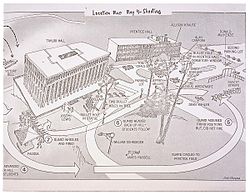Kent State
| Tomorrow is a mystery, but yesterday is History |
| Secrets of times gone by |
Kent State is the old name for Kent State University, a division of the University System of Ohio located in Kent, Ohio. But that's not why it's famous.
Prelude[edit]
On May 1, 1970, at closing time on a Saturday night, hundreds of Kent State students poured out of bars and began harassing motorists and committing vandalism, including spray painting ant-war slogans.[1] The mayor of Kent, LeRoy Satrom (1919–2004) who was a conservative Democrat, had just gotten elected on a platform of getting tough on "long-haired students".[1] Satrom's response to this was to call Ohio Governor Jim Rhodes (1909–2001), a Republican, and ask that he mobilize the National Guard at Kent State.[1] Rhodes met with state and local university officials on May 3, but — in large part because he desired to win a Senate seat in the next election, and wanted to show that he would use "all the force that was necessary" against campus unrest in Ohio — he ignored their advice.[1] When someone asked Rhodes to define a protest, he replied: 'Two students walking together.'"[1][2] Journalists had learned of this meeting and entered the room uninvited, at which point:
“”Rhodes grew theatrical. Pounding his fists on the conference table, he declared in an angry voice, "We're going to put a stop to this!" and "we are going to eradicate the problem!" and "they're the worst type of people that we harbor in America!" The table-thumping performance only added fuel to the blaze of confrontation.
|
Shooting[edit]
On a lovely spring day in the early seventies, May 4, 1970, to be exact, protesters against the Nixon administration's expansion of the Vietnam War into neighboring Cambodia were confronted by members of the Ohio National Guard. A guardsman later stated, "We had no understanding as to the amount of force we were supposed to use to accomplish that mission. There had not been a briefing before we moved out to explain what to do and how to do it."[1] Since the Guard had guns and the students only had rocks and words, tragedy ensued. Four young people — Jeffrey Miller, Allison Krause, William Schroeder, and Sandra Scheuer — were killed that day. Two were protesters, and two were simply walking from one class to another.[3] One of the murdered students was actually a ROTC (Reserve Officers' Training Corps) member; he was the only one of the four for whom Richard Nixon bothered to personally call the parents.
Aftermath[edit]
The state of Ohio then had the chutzpah to press charges — not against the Ohio National Guardsmen, but against 25 other students involved in the protests, known as the Kent 25. Most of the charges were eventually dropped.[4][5]
In yet another example of the Silent Majority keeping it classy, bumper stickers reading "Army 4, Kent State 0" appeared; union construction workers in New York City, mobilized by the local AFL-CIO leadership to hold a pro-Vietnam War rally, rioted and attacked antiwar protesters who had gathered to remember the Kent State dead,[6] and Nixon and his White House general counsel, Chuck Colson, then invited the leaders of the construction worker riot for a warm welcome and a "well done" at the White House. Nixon appointed the local Construction Trades union leader and instigator of the riot, Peter Brennan, as Secretary of Labor during his second term.
Devo[edit]
Two of the members of the band Devo (Mark Mothersbaugh and Jerry Casale) were students at Kent State at the time of the murders, and a third (Bob Mothersbaugh) was on campus at the time.[7] The three were witnesses or participants to the preceding student unrest, and witnesses to the murders.[7] The murders were profoundly influential on the three members, and led to their formation of Devo, as well as to their using the term devolution as a reference to how they saw humanity going.[8] According to Casale, the Kent State murders were also one of the instigators of punk rock.[9]
See also[edit]
External links[edit]
- See the Wikipedia article on Kent State Shootings.
- An analysis of the Neil Young song "Ohio"
References[edit]
- ↑ 1.0 1.1 1.2 1.3 1.4 1.5 The grim history of using troops against student protesters by Brian VanDeMark (April 26, 2024 at 6:02 p.m. EDT) The Washington Post.
- ↑ Kent State: An American Tragedy by Brian VanDeMark (August 13, 2024) W. W. Norton & Company. ISBN 1324066253.
- ↑ MISSION BETRAYED: Richard Nixon and the Scranton Commission Inquiry into Kent State, An e-book by Charles A. Thomas (partial work), Charles A. Thomas Papers, Kent State University May 4 Collection.
- ↑ http://www.burr.kent.edu/archives/may4/twentyfive/twentyfive1.html
- ↑ http://dept.kent.edu/sociology/lewis/lewihen.htm
- ↑ http://www.spectacle.org/595/kent.html
- ↑ 7.0 7.1 Devo's Mark Mothersbaugh and Jerry Casale remember the Kent State Massacre by Bryan Thomas (May 4, 2017) Nightflight (archived from May 7, 2015).
- ↑ Mark Mothersbaugh Explains How Tragedy Inspired Devo in Animated Clip: Kent State shootings helped usher in the age of "Devolution," artist says by Daniel Kreps (March 6, 2015) Rolling Stone.
- ↑ How the Kent State massacre helped give birth to punk rock by Tim Sommer (May 3, 2018) The Washington Post.

